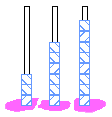abacus (drinking straws and plasticine)
place value mat
recording sheet
paper money
| 1. | Construct the following numbers on the abacus and record your work on the recording sheet. Use proper metric notation. | |
| a) | 506 231 | |
| b) | 2 255. 234 | |
| c) | five thousand three hundred thirty-six | |
| d) | three hundred forty and three tenths | |
| e) | 6 thousands, 4 ones, 2 hundreds, 3 tenths | |
| f) | 5 hundredths, 3 hundreds, 3 tenths, 3 tens, 0 ones, 6 thousandths, 8 thousands |
|
| 2. | We can represent "368" using several models. | |

BASE TEN BLOCKS

ABACUS
| 3. | Represent five hundred forty six using Base ten blocks and an abacus. | |
| a) | Represent this number as money by cutting and gluing the paper money on a piece of paper. | |
| b) | Does your money model look more like the Base ten blocks or more like the abacus. Explain your answer. | |
| c) | Give the advantages and disadvantages of each model. | |